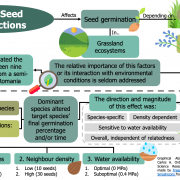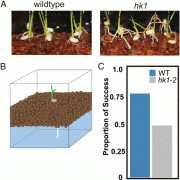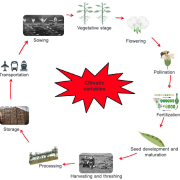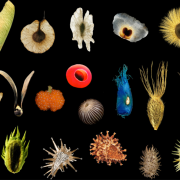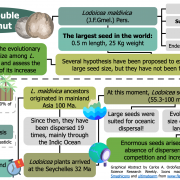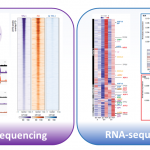Coleorhiza‐enforced seed dormancy: a novel mechanism to control germination in grasses (New Phytol.)
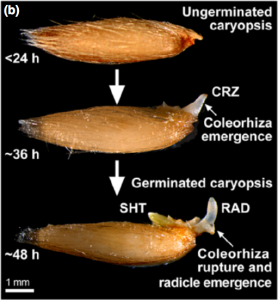 The germination process is completed when the radicle emerges from the seed. In eudicots, radicle growth is mechanically limited by the micropylar endosperm. As dormancy is broken and imbibition occurs, this structure is weakened so that radicle can pierce it. In grasses, the radicle is not surrounded by endosperm, but a sheath-like tissue called the coleorhiza. Still, little is known about the role of this structure in the regulation of radicle emergence. In this paper, Holloway and colleagues show that coleorhiza shapes radicle emergence in Avena fatua and that this control depends on the seed dormancy state. Dormant seeds could germinate if their coleorhiza were experimentally removed, confirming it constrains radicle’s emergence. Moreover, the authors show that if seeds are dormant upon imbibition, the coleorhiza becomes more robust and harder to pierce by the radicle. Contrastingly, if dormancy has been broken, the coleorhiza is weakened as imbibition occurs, facilitating radicle protrusion. These divergent behaviors arise from the recruitment of different groups of xyloglucan endo-transglycosylases/hydrolases that contribute to either loosen or harden coleorhiza cell walls, depending on seed dormancy state. As a result, this research provides exciting insights into the coleorhiza’s role in seed dormancy and the biochemical mechanisms behind it. (Summary by Carlos A. Ordóñez-Parra @caordonezparra) New Phytol. 10.1111/nph.16948
The germination process is completed when the radicle emerges from the seed. In eudicots, radicle growth is mechanically limited by the micropylar endosperm. As dormancy is broken and imbibition occurs, this structure is weakened so that radicle can pierce it. In grasses, the radicle is not surrounded by endosperm, but a sheath-like tissue called the coleorhiza. Still, little is known about the role of this structure in the regulation of radicle emergence. In this paper, Holloway and colleagues show that coleorhiza shapes radicle emergence in Avena fatua and that this control depends on the seed dormancy state. Dormant seeds could germinate if their coleorhiza were experimentally removed, confirming it constrains radicle’s emergence. Moreover, the authors show that if seeds are dormant upon imbibition, the coleorhiza becomes more robust and harder to pierce by the radicle. Contrastingly, if dormancy has been broken, the coleorhiza is weakened as imbibition occurs, facilitating radicle protrusion. These divergent behaviors arise from the recruitment of different groups of xyloglucan endo-transglycosylases/hydrolases that contribute to either loosen or harden coleorhiza cell walls, depending on seed dormancy state. As a result, this research provides exciting insights into the coleorhiza’s role in seed dormancy and the biochemical mechanisms behind it. (Summary by Carlos A. Ordóñez-Parra @caordonezparra) New Phytol. 10.1111/nph.16948



